Physical Address
304 North Cardinal St.
Dorchester Center, MA 02124
Flat or slightly raised, round or oval, pigmented lesions of the retinal pigment epithelium (RPE).
Located predominantly at the mid-periphery; less commonly at the posterior pole ( Fig. 48.1 ).
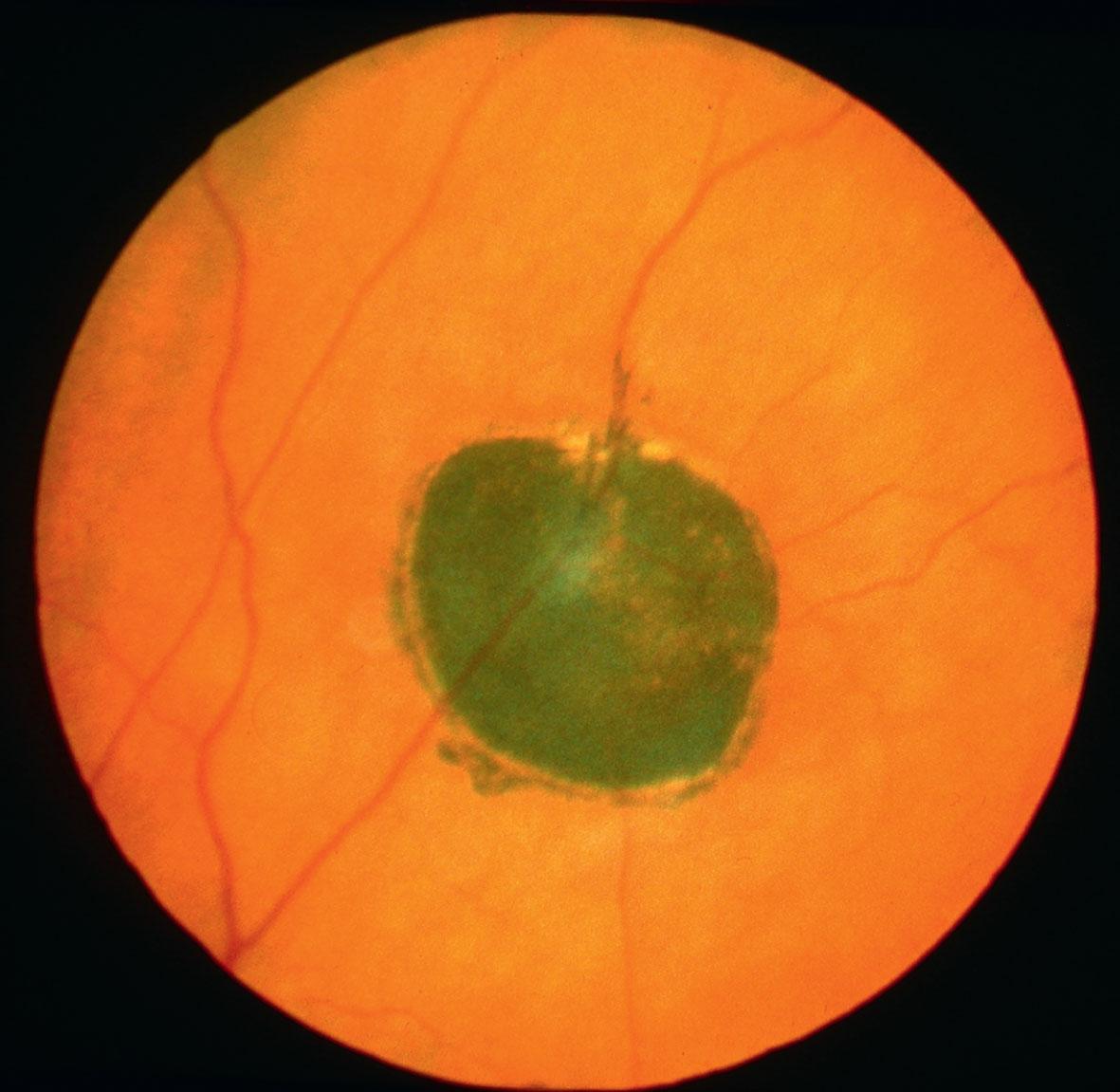
Pigmented and non-pigmented halo surround lesions.
Multiple intralesional depigmented lacunae corresponding to areas of RPE loss.
Depigmented CHRPEs are less common.
Intensely pigmented RPE cells that are 1.5–2 times the height of normal RPE cells and contain large spherical melanosomes.
Optical coherence tomography (OCT): photoreceptors and outer retinal layers absent directly overlying the lesion.
Autofluorescence (FAF): absence of autofluorescence within the lesion, indicating a lack of lipofuscin, with punctuated areas of isoautofluorescence.
Fluorescein angiography (FFA): demonstrates choroidal masking.
Visual field testing shows a visual field defect corresponding to the photoreceptor loss.
CHRPE has a prevalence of between 1.2% and 4.4% in the general population. Age at presentation ranges from infancy to 80 years.
Vessel sheathing, attenuation, and microangiopathy, drusen, adjacent white-without-pressure, and depigmented linear RPE streaks.
Lesions enlarge in 83% of patients at a median rate of 2 μm per millimeter lesion-base per month due to flattening and shifting of cells to accommodate normal attrition of the surrounding RPE.
In adults, 1.5% of lesions may contain a nodular component associated with remote macular edema or malignant transformation within lesions.
Multiple (more than three), bilateral, mixed pigmented and depigmented CHRPE are a highly specific and sensitive marker of adenomatous polyposis of the colon (APC) or familial adenomatous polyposis (FAP) and are highly penetrant, seen in around 75% of affected individuals. APC-associated CHRPEs are:
Ovoid, pisciform or irregular in shape, surrounded by a pale-gray halo or adjacent depigmented linear streaks ( Fig. 48.2 ).
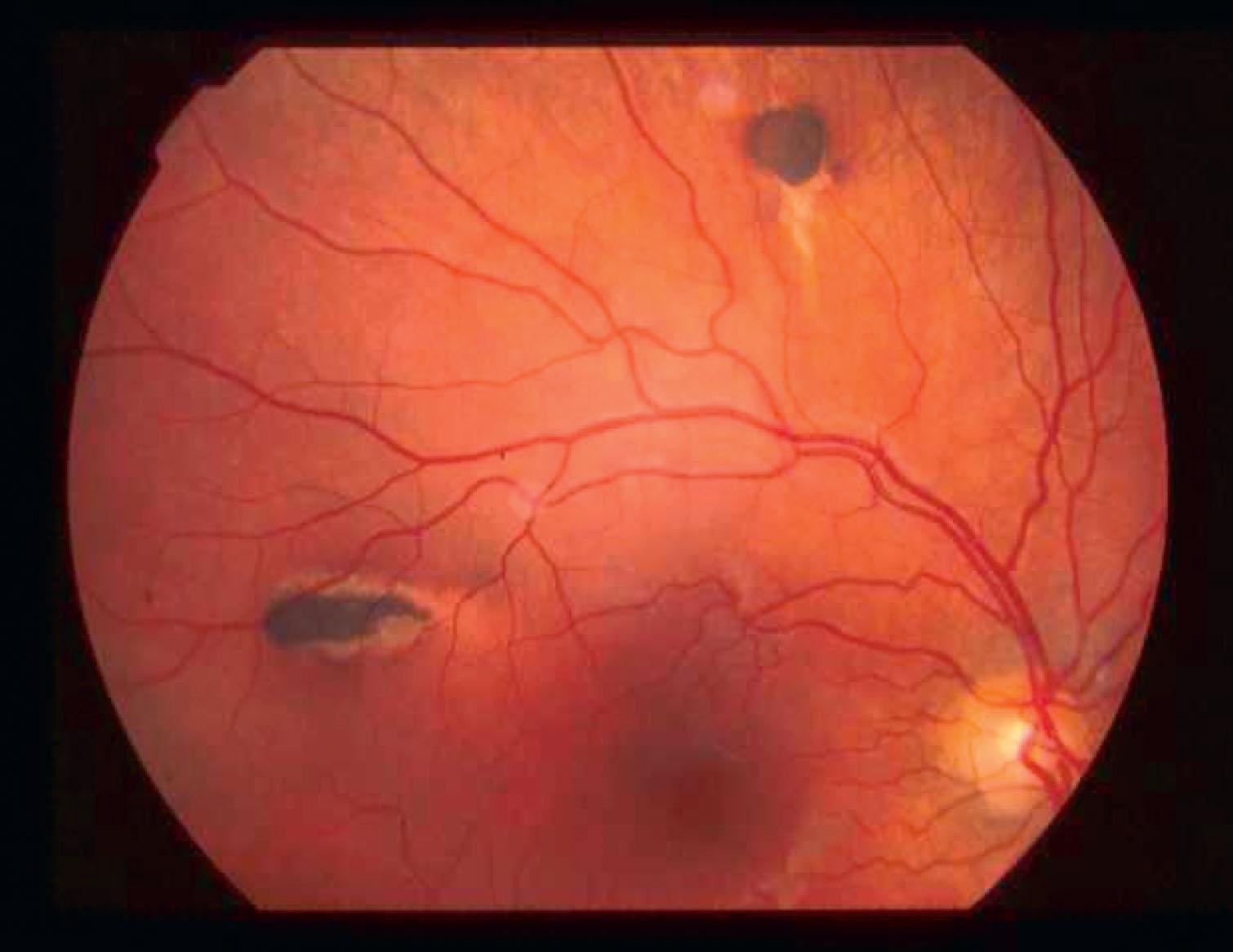
Variable sizes and location, from dot-like lesions to multiple disc diameters occurring in multiple quadrants.
Present at birth and do not grow throughout life.
Diffuse RPE abnormalities include enlargement of RPE cells outside the lesional area containing enlarged, round melanin granules.
Autosomal dominant (AD) with an incidence of 1 in 8300.
Accounts for ~1% of all colorectal cancers.
Associated with mutations of APC :
Extra-colonic manifestations: osteoma; odontomas; supernumerary teeth; desmoid tumors; primary brain medulloblastoma; hepatoblastoma; cribriform-morular variant of papillary thyroid cancer.
Also found in APC families without such extra-colonic manifestations.
Attenuated FAP is associated with fewer colonic polyps, older average age at diagnosis of colonic cancer, and less frequently associated with CHRPE.
The APC gene is a tumor suppressor gene on chromosome 5q21–22. CHRPEs suggest the presence of a mutation between codons 148 and 2043. Multiple adenomatous colorectal polyps (>100) appear between the second and fourth decades. Without treatment malignant transformation is invariably seen, with a mean age at diagnosis of 39 years. Colonoscopy is recommended from 12 years and may lead to elective colectomy. Polyps may exist in the upper gastrointestinal tract including stomach, small bowel, and duodenum, the latter being associated with a significant risk of malignant transformation.
Small, darkly pigmented, flat, circumscribed lesions at the level of the RPE (also known as “bear tracks”).
Increasing in size as they approach the retinal periphery ( Fig. 48.3 ), occasionally forming gigantiform lesions, several disc diameters in size.
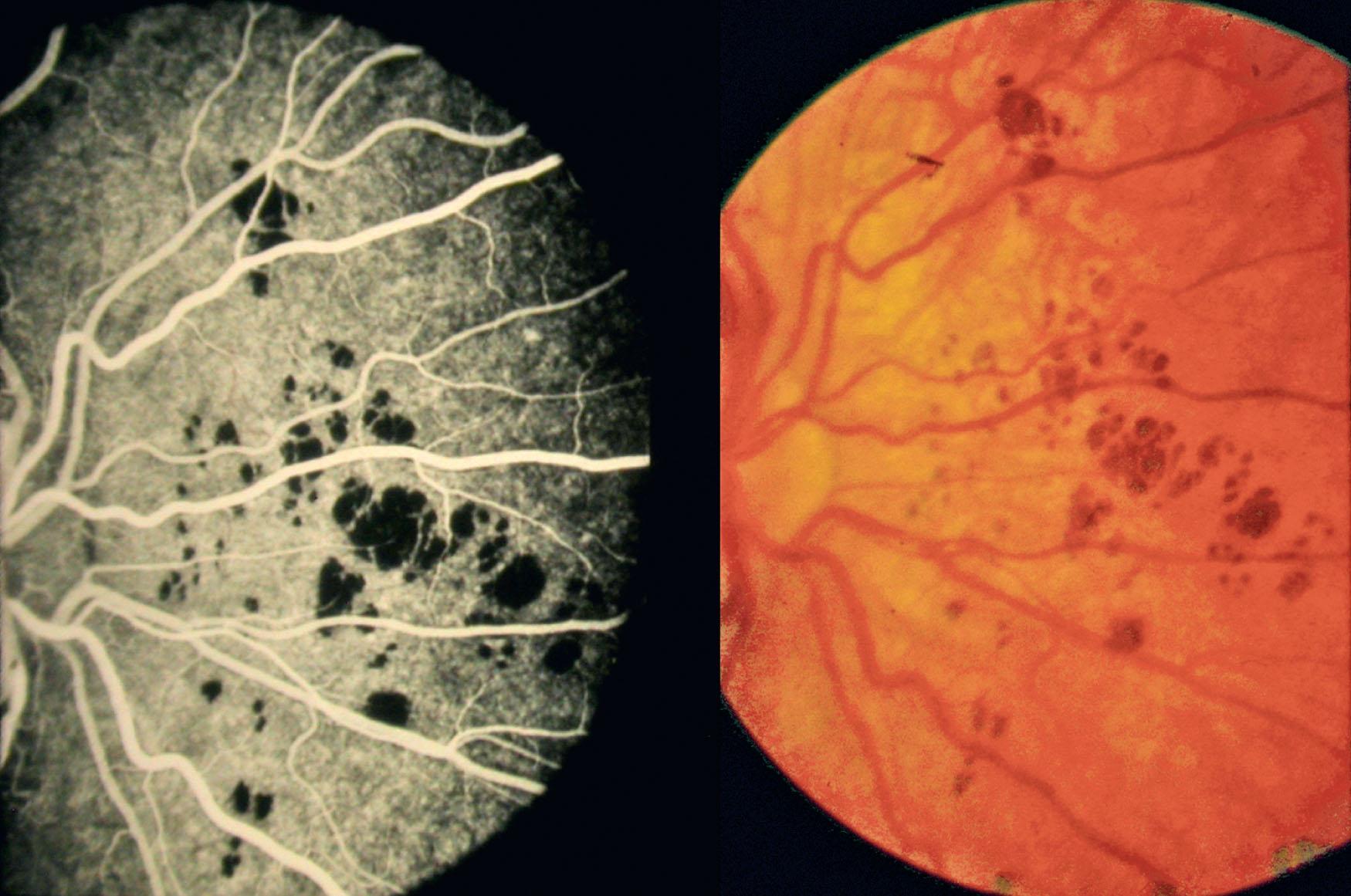
Unilateral and sectorial, rarely involving macula with normal visual function. Occasionally involving the entire fundus.
Depigmented variant of the same size, shape, and distribution as the pigmented form, “polar bear tracks.” Associated choroidal neovascularization has been reported. Pigmented and depigmented lesions may coexist within the same patient.
The prevalence is 0.12% in the ophthalmic clinic population.
Usually isolated but possible chance associations include:
Retinoblastoma.
Café-au-lait spots and hairy nevus.
Persistent fetal vasculature.
Microcephaly.
Rieger anomaly.
Macular coloboma.
Grouped pigmentation of RPE is not associated with FAP and patients do not require colonoscopy.
Circumscribed, nodular, and heavily pigmented lesion located within the macula region close to the fovea. Possibly arising from RPE, projects full thickness of the retina into vitreous.
A feeder arteriole and venule are usually present.
Subtle surrounding retinal traction may reduce visual acuity. May be associated with macular edema.
Ultrasound: nodular, echogenic mass with moderate-to-high internal reflectivity.
FFA: demonstrates a non-fluorescent lesion with a variable surrounding ring of late hyperfluorescence.
Short-wave FAF shows hypoautofluorescence and mixed reflectivity using near-infrared reflectance.
OCT: elevation of the inner retina with enhanced reflectivity of its vitreal face and marked optical shadowing at the level of the outer retina and choroid, with normal retina immediately adjacent to lesion.
OCT-angiography (OCT-A) demonstrates intrinsic vascularization at the level of the inner and outer capillary plexus with apparent continuity with the surrounding retinal vascular network.
Adaptive optics imaging shows good preservation of functional cones within the intralesional area with normal levels of retinal sensitivity.
The lesions are congenital, stable, and asymptomatic but can show adjacent intraretinal hemorrhage and exudation.
Rare, benign, solitary lesions involving neurosensory retina, RPE, and vitreous in varying extents.
Usually unilateral, but bilateral cases are described.
Located at the posterior pole in the papillary/peripapillary or macular region or in peripheral retina.
Likely to be congenital; cases described in infants as young as 2 weeks of age.
Mostly non-progressive.
The majority present with reduced vision, metamorphopsia, or strabismus, particularly with macular involvement or macular ectopia. Complications include retinal and vitreous hemorrhages, retinal and choroidal neovascularization, retinoschisis, retinal detachment (usually exudative), and macular edema.
Peripapillary lesions may be associated with intraretinal or subretinal exudation in the papillomacular bundle, choroidal neovascular membranes, and vitelliform lesions.
Lesions are elevated with variable pigmentation ( Fig. 48.4A ). Retinal vascular tortuosity and an overlying epiretinal membrane are typical. Lesions can be classified as melanocytic, vascular, or glial. Glial subtypes with epiretinal membrane (ERM) can cause progressive retinal traction resulting in visual loss but may be amenable to surgery.
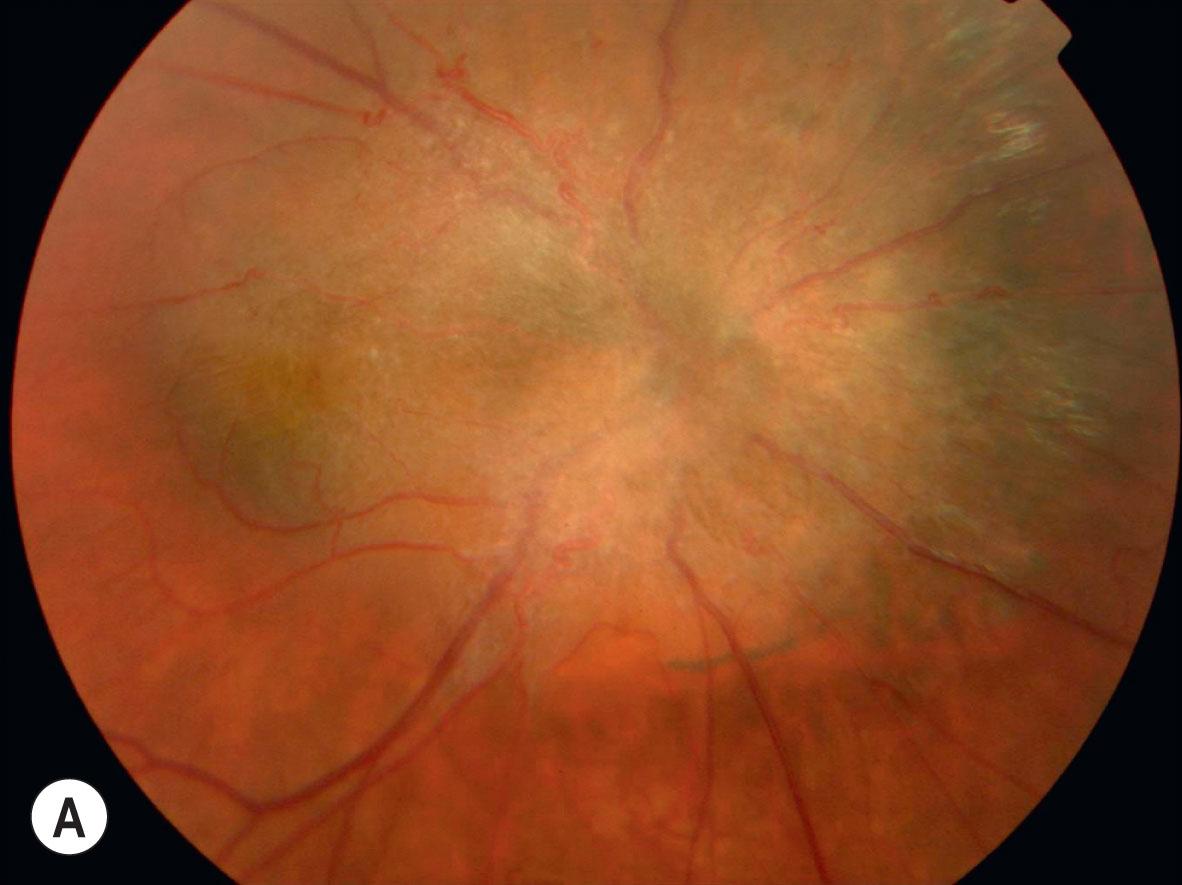
FFA: hypofluorescence of background choroid during arterial phase, underlying retinal vascular tortuosity, capillary dilation within the lesion, and intralesional vascular leakage ( Fig. 48.4B ).
FAF shows characteristic pronounced hypofluorescence obscuring superficial retinal vasculature in peripapillary lesions.
Near infrared imaging is useful for clearly demarcating the lesion boundary.
OCT: hyperreflective epiretinal membrane with mini peaks involving inner retina. Larger infolding of the deeper retinal layers, termed “maxi-peaks’” limited by the outer plexiform layer, termed “omega sign,” are typically seen in macular lesions. Peripapillary lesions have full-thickness involvement with folds extending to outer retina, retinal thickening, and disorganization, underlying choroid thinning and tractional retinoschisis.
Thickened, disorganized retina and, if involved, optic nerve with abundant hyperplastic and dysplastic glial cells.
Peripapillary lesions show reduplicated sheets and cords of proliferating RPE infiltrating the overlying tissue. Macular CHRRPE show RPE hypertrophy and hyperpigmentation without reduplication or migration of RPE into retinal layers.
Capillary hyperplasia and fibrous tissue proliferation overlying the lesion folding the anterior lesion surface.
Notable associations include neurofibromatosis (NF) 1 and 2, Gorlin syndrome, and tuberous sclerosis.
Rarer associations include Poland anomaly, branchio-oculofacial syndrome, branchio-oto-renal syndrome, juvenile nasopharyngeal angiofibroma, incontinentia pigmenti, juvenile retinoschisis, optic disc coloboma, and optic nerve head drusen.
CHRRPEs may be classified according to retinal zone (1–3) with three stages of increasing severity of traction and, based on OCT appearances, three increasing grades of retinal and RPE involvement. Risk of visual loss and frequency of monitoring is modified accordingly.
Progressive ERM traction affecting the macula may require intervention where loss of vision can be demonstrated. Surgery may restore foveal vascular morphology as depicted by OCT-A, together with structural and functional improvement.
An ovoid, sharply defined, non-pigmented lesion in the temporal region of the macula, centered on or close to the horizontal raphe (see Fig. 48.5 ). Usually an asymptomatic incidental finding.
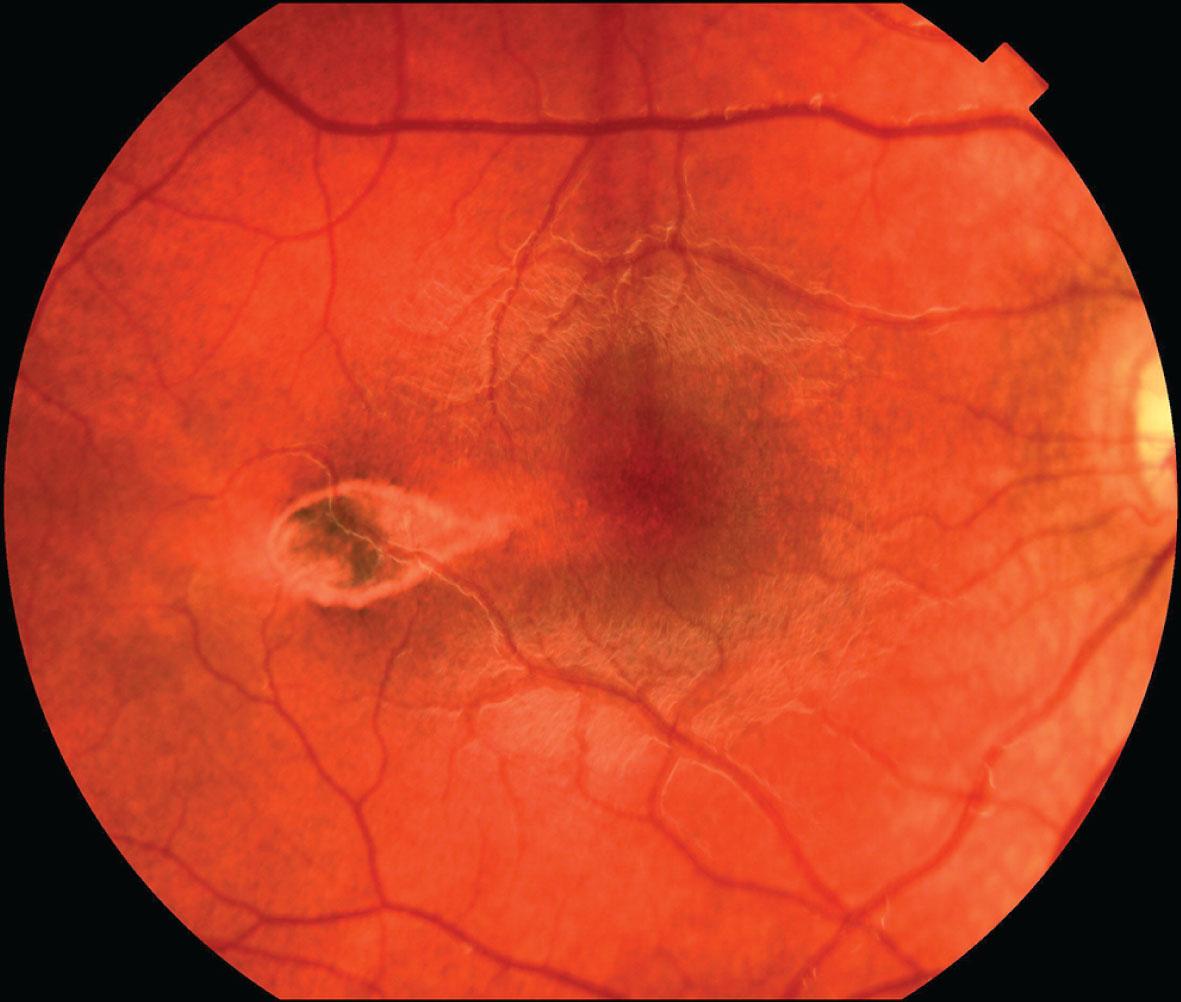
Lesions are longer horizontally (2–3 mm) than vertically (1 mm) and point toward the fovea with either a frayed, pigmented tail or rounded margin located temporally.
Usually unilateral and unifocal, although satellite or multiple lesions have been described temporal to the main lesion.
They have a hyperpigmented border.
Occasionally associated with choroidal neovascular membranes.
Become a Clinical Tree membership for Full access and enjoy Unlimited articles
If you are a member. Log in here